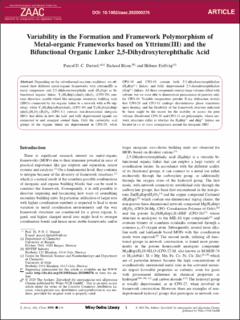| dc.contributor.author | Dietzel, Pascal D.C. | |
| dc.contributor.author | Blom, Richard | |
| dc.contributor.author | Fjellvåg, Helmer | |
| dc.date.accessioned | 2021-02-19T12:13:19Z | |
| dc.date.available | 2021-02-19T12:13:19Z | |
| dc.date.created | 2020-12-14T11:53:27Z | |
| dc.date.issued | 2021 | |
| dc.Published | Zeitschrift für anorganische und allgemeine Chemie. 2020, 1-12. | |
| dc.identifier.issn | 0044-2313 | |
| dc.identifier.uri | https://hdl.handle.net/11250/2729226 | |
| dc.description.abstract | Depending on the solvothermal reaction conditions, we obtained three different metal‐organic frameworks with yttrium(III) as metal component and 2,5‐dihdyroxyterepthalic acid (H4dhtp) as bifunctional organic linker: Y2(H2dhtp)3(dmf)4·(dmf)2 (CPO‐29) contains dinuclear, paddle‐wheel like inorganic secondary building units (SBUs) connected by the organic linker to a network with α‐Po topology, while Y2(H2dhtp)(dhtp)(dmf)2 (CPO‐30) and Y2(H2dhtp)(dhtp)(dmf)2(H2O)2·(H2O)4 (CPO‐31) contain one‐dimensional inorganic SBUs that differ in how the half‐ and fully deprotonated ligands are connected to and arranged around them. Only the carboxylic acid groups of the organic linker are deprotonated in CPO‐29, while CPO‐30 and CPO‐31 contain both 2,5‐dihydroxyterephthalate (H2dhtp2–) linkers and fully deprotonated 2,5‐dioxidoterephthalate (dhtp4–) linkers. All three compounds contain large volumes filled with solvent, but we were able to demonstrate permanence of porosity only for CPO‐30. Variable temperature powder X‐ray diffraction reveals that CPO‐29 and CPO‐31 undergo discontinuous phase transitions upon heating, and the flexibility of the framework structure indicated by these might be the reason for the inability to access the pore volume. Desolvated CPO‐30 and CPO‐31 are polymorphs, whose network structures differ in whether the H2dhtp2– and dhtp4– linkers are located in cis or trans arrangement around the inorganic SBU. | en_US |
| dc.language.iso | eng | en_US |
| dc.publisher | Wiley | en_US |
| dc.rights | Navngivelse 4.0 Internasjonal | * |
| dc.rights.uri | http://creativecommons.org/licenses/by/4.0/deed.no | * |
| dc.title | Variability in the formation and framework polymorphism of metal-organic frameworks based on yttrium(III) and the bifunctional organic linker 2,5-dihydroxyterephthalic acid | en_US |
| dc.type | Journal article | en_US |
| dc.type | Peer reviewed | en_US |
| dc.description.version | publishedVersion | en_US |
| dc.rights.holder | Copyright © 2020 The Authors. | en_US |
| cristin.ispublished | true | |
| cristin.fulltext | original | |
| cristin.qualitycode | 1 | |
| dc.identifier.doi | 10.1002/zaac.202000276 | |
| dc.identifier.cristin | 1859462 | |
| dc.source.journal | Zeitschrift für anorganische und allgemeine Chemie | en_US |
| dc.source.pagenumber | 15-25 | en_US |
| dc.identifier.citation | Zeitschrift für anorganische und allgemeine Chemie. 2021, 647 (1), 15-25. | en_US |
| dc.source.volume | 647 | en_US |
| dc.source.issue | 1 | en_US |

